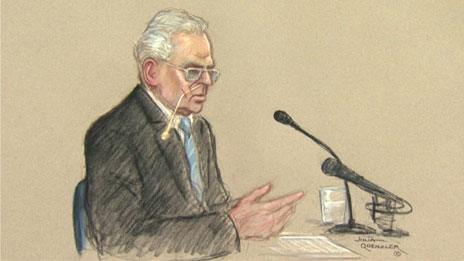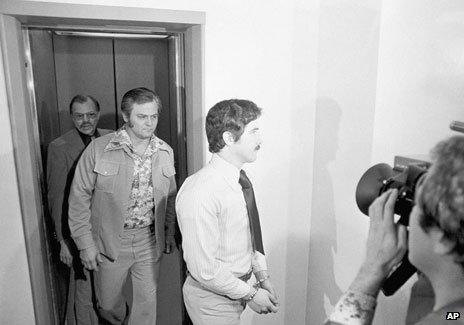Ian Brady: Is it possible to feign mental illness?
- Published

A tribunal is set to decide whether Ian Brady is moved from a psychiatric hospital back to prison. The Moors Murderer has said he used "method acting" techniques to fool those around him. How common is the practice?
Staff at Ashworth Hospital argue Ian Brady is a paranoid schizophrenic, and should stay in their care.
But Brady, who killed five children, says he was pretending the entire time, using the method acting techniques of Constantin Stanislavski to fool doctors and psychologists.
Whether or not Brady is telling the truth, the issue is one psychiatrists - particularly those working with criminals - have had to deal with for many years.
In 2007, Stuart Harling was jailed for life, external for the murder of nurse Cheryl Moss in Essex. Harling's lawyers claimed he suffered from a personality disorder, but the jury didn't believe his unstable behaviour in court - which included hurling papers from the dock and shouting threats - and rejected his claims of innocence on the grounds of diminished responsibility.
In 1996, a jury in Glasgow rejected James Lindsay's insanity plea, external and he was sentenced to life for murdering 15-year-old Emma Thomson. While awaiting trial, Lindsay wrote to a friend from Barlinnie Prison: "I've a cunning plan to get into Carstairs [psychiatric hospital] and be released after eight years."
But the Hillside Strangler, Kenneth Bianchi, represents perhaps the classic case of a criminal faking a mental disorder.
Apprehended for a dozen murders of young women in California, Bianchi managed to persuade several respected experts - while under hypnosis - that he had an unpleasant alter ego called "Steve". It was "Steve" who that had committed the horrific crimes, Bianchi claimed.

Murderer Kenneth Bianchi (in handcuffs) managed to fool several experts
If the experts' diagnosis of multiple personality disorder was allowed to stand, Bianchi would be able to plead not guilty - by reason of insanity - and would be unable to give evidence against his co-accused, Angelo Buono.
But investigators brought in another psychologist, Martin Orne, an expert in hypnosis, who was able to uncover Bianchi's ruse.
Told by Orne that multiple personality disorder patients usually had at least three personalities, Bianchi promptly invented another, called "Billy". Bianchi also exaggerated his confusion at seeing the evidence of actions committed by "Steve" - such as the removal of filter tips from cigarettes during a previous interview.
A police search of Bianchi's house turned up a raft of textbooks on psychology, behavioural science, hypnosis and police procedure law. He had also viewed the movies Sybil and Three Faces of Eve, both dealing with multiple personality disorder.
He had taken the name of his alternate personality - Steve Walker - from that of a psychology student whose identity he had faked earlier in order to obtain accreditation.
While Orne and the police were never fooled, several experts had been.
Sentencing Bianchi, the judge said: "In this Mr Bianchi was unwittingly aided and abetted by most of the psychiatrists who naively swallowed Mr Bianchi's story hook, line and sinker."
The theme has proved popular in fiction, too. In One Flew Over the Cuckoo's Nest, Randle P McMurphy fakes psychiatric illness to avoid prison, only to find himself in a situation he cannot get out of.
Shakespeare's Hamlet invoked a similar tactic, putting on "an antic disposition" to buy himself time and plot revenge for his father's death.
Several studies in the US suggest that of those assessed for a psychiatric disorder, about 7% are believed to be faking.
In criminal cases, the number is higher. Phillip Resnick, a professor of psychiatry at the Case School of Medicine in Ohio, says the incidence also increases with the severity of the crime.

"I essentially am not in madness, but mad in craft" (Hamlet)
"If a person is facing the death penalty, for example, it happens much more often."
In those cases, studies based on psychological testing suggest that people are faking in about 12-15% of cases, he says. Others place the figure as high as 22%.
Although the methods are not infallible, experts have devised a series of increasingly sophisticated tests to spot false claims. Eluding detection "would take a very skilful malingerer", says Resnick.
The most common giveaway is the overstating of symptoms, creating an unrealistic picture of their supposed illness.
Amory Clarke, a clinical psychologist at the South London and Maudsley NHS Foundation Trust says that "people report dramatic, embellished symptoms which are just too extreme and histrionic to be real".
In clinical tests, psychologists suggest a series of symptoms to the patients, some of which match a particular condition and others that don't. A faker might admit to having continuous hallucinations, for example, which would tend to indicate exaggeration.
"You're trying to lead them into saying they have a set of symptoms which it's not possible to have. If they say they are experiencing them, you have a very strong basis for determining that they're lying," says Clarke.
Avoiding detection is not impossible, though, says Resnick. Fakers are at a distinct advantage if they have experienced a genuine psychotic episode in the past. Even having witnessed psychosis first hand - in a relative or at a hospital - can aid a more accurate performance.
In the last few decades, diagnoses have become more accurate, but in the past techniques were much cruder. An experiment in the early 70s exposed several problems in the system.
Psychologist David Rosenhan instructed five healthy people to pretend they were experiencing hallucinations and try to gain access to psychiatric hospitals across five US states.
All of them were admitted and diagnosed with psychiatric disorders, at which point they began acting normally again. Slowly, all negotiated their release from the institutions under the condition that they admit to being mentally ill - most receiving an official diagnosis of schizophrenia.
Hearing about the experiment, staff at one teaching hospital were convinced they couldn't be duped so easily. They challenged Rosenhan to try again, pledging to detect any malingering subjects he sent them.
Over a three-month period, the hospital claimed to have found 41 imposters and a further 42 suspects, from a total of 193 cases. But Rosenhan confessed he hadn't sent a single "patient".
Though criticised for wilfully attempting to trigger false diagnoses, the study is widely credited with highlighting problems in the way mental institutions functioned, and accelerating the movement to reform them.
The process remains problematic, however, and controversy still persists today.
Marjorie Wallace, head of mental health charity Sane, says "the difficulty lies in the lack of precision in diagnosis". She notes Moors Murderer Ian Brady's case as a particularly vexing example.
"As seems the case with Brady, the mental illness is compounded by severe personality disorder, which can make a person highly devious and convincing."
Roger Graef, a visiting professor at the Mannheim Centre for Criminology agrees. Whilst feigning mental illness is extremely difficult for most, "really smart people understand the game and play it", he says.
"For people like Brady, it's very hard to tell."
Additional reporting by Vanessa Barford
You can follow the Magazine on Twitter, external and on Facebook, external